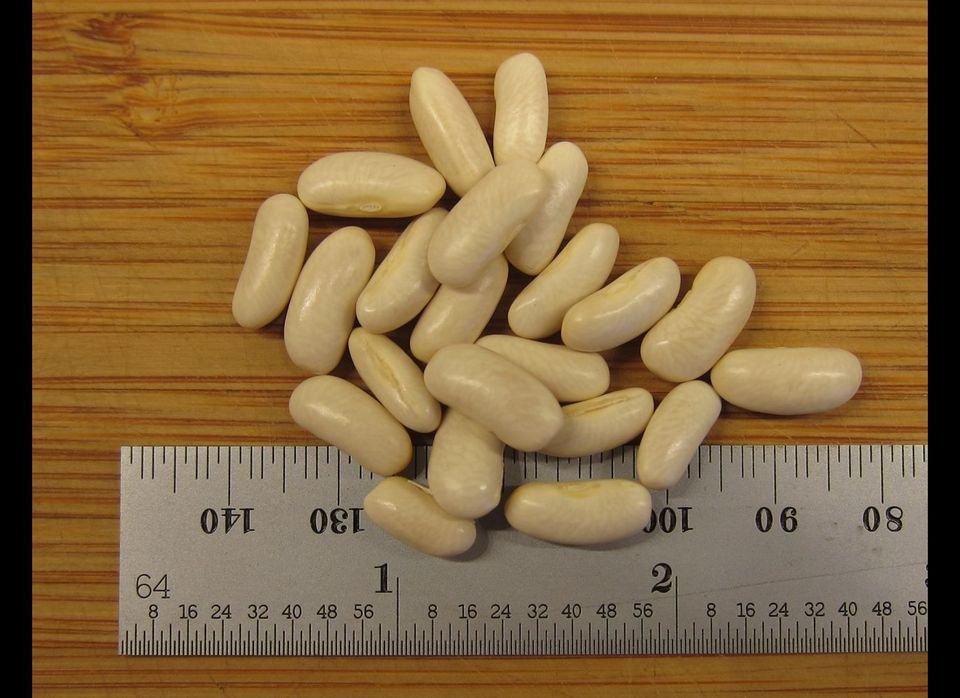Before and after last week's pasta e fagioli with celeriac, beans have repeatedly been on the menu at our house this winter (actually, fall, even though it's snowing outside), with pork, with duck, with lamb and with other vegetables, mainly in soups and braised dishes. Once, with the addition of extra bean broth, the remains of a duck and pork belly braise morphed into a hearty soup that was good enough to serve to guests.
Most recently, I made something completely different. I was looking at photographs from an September-October trip, and these reminded me that in two restaurants, one in London and one in the Hampshire countryside, Jackie and I ate fish on a bed of white beans (in both cases, French coco beans, which are very like our great northern beans and which you see a lot of in Britain). The version I slightly preferred, at London's Merchants Tavern, was a little lighter and the sauce part of the bean mixture a little less dense (though it still contained bean puree to give it some body). It had a lovely aroma of rosemary if I remember aright, and even if it didn't it was rosemary that came to mind as I thought about making something along the same lines at home.
The first thing to consider was the beans (the fish would not be identified until a visit to the farmers' market a day or two later). I was going to cook a pound of cannellini anyway, and these were already soaking. But there was also this Ziploc bag of beautiful little elongated white beans. Unlabeled, of course, and hence anonymous, though I did remember their having entered the apartment within the past year. (If anyone recognizes them from the photograph, please ID them by leaving a comment on this post.) Whatever they were, between their relative youth and their small size, they needed only a few hours of soaking until they were swollen and soft enough to bite into easily. Using my more or less Tuscan method, I brought them to the boil very, very slowly in salted water with a little oil and, in this case, a sprig of fresh rosemary and a small clove of garlic, peeled but whole. At a bare simmer, they were tender in about an hour -- though that is not something you can count on with whatever beans you might use: great northerns, cannellini and other white beans are certain to take longer unless they were dried very recently or unless you cook them in a pressure cooker, which works very well.
I removed all the rosemary leaves (which of course had detached from the stem and had to be picked out one by one) and the garlic, and let the beans cool in their broth before refrigerating them.
A couple of mornings later, the (snow-dusted) farmers' market offered quite a few viable fish options, among them striped bass. It is hard to resist that fish, and it is a safe choice for company -- no one doesn't like it, except for those who don't eat fish at all of course.
When I got home, I took some of the cooked beans and their broth, heated them in a little pan and pureed them using an immersion blender. The goal was a creamy consistency and good flavor; by tinkering with the quantity of broth the former was easy to attain, and the latter was ninety percent built in: the beans were delicious and the rosemary-garlic-olive-oil flavor present but not obtrusive. Still, because fish was on the menu and because lemon and rosemary always get along extremely well, I also added the grated zest and the juice of half a medium lemon, resulting in a brighter but still beany flavor. I also reinforced the rosemary flavor with a teaspoonful of chopped fresh rosemary leaves.
At dinner time, I separately reheated the whole beans and the puree (checking seasoning), then turned to the striped bass. The seasoned fish was cooked plain in a skillet with olive oil; when the skin had browned I put the pan into the oven to finish cooking the flesh. If the oven hadn't been on for another purpose, I'd have cooked it all the way on top of the stove. You could also steam the fish; though you'd miss the nice crisp skin, the outcome would be lovely -- softer both in flavor and in texture.
Just before the fish was done, I put some beans and some puree onto each (heated) plate, then topped this with a piece of fish. I thought of drizzling each serving with good olive oil, but thought better of it: there was still a residual olive-oil aroma from the initial cooking of the beans, and there was no need to reinforce this -- though it wouldn't have done any harm and you might like to try it.
The simplicity of this dish is striking. It is just cooked beans on a plate topped with a piece of fish. But with good beans, good seasoning and good fish, it is a real pleasure to eat. And it makes a nice diversion from the usual round of heavier wintery bean dishes -- to which we are now eagerly reverting before today's snowfall melts.
